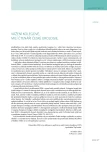Our experience with shock waves therapy in patiens with Peyronie’s disease (average follow-up of 13 months)
Authors:
Pavel Drlík; Oto Köhler
Authors‘ workplace:
Urologické oddělení ÚVN, Praha
Published in:
Ces Urol 2010; 14(3): 180-185
Category:
Original article
Overview
Aim:
Authors retrospectively evaluate results of extracorporal shock waves therapy (ESWT) in patients with Peyronie´s disease after unsuccessful conservative treatment. ESWT was performed on electrohydraulic lithotriptor MEDILIT 7. Time of surveillance was on the average of 13 months.
Material and method:
We treated group of 18 men aged 29 to 74 years old (on average 56 years old). All patiens were after unsuccessful conservative treatment (heterogenous group following vitamine therapy, hydrocortisone application, verapamil and ultrasound treatment) – duration of symptoms was more than one year. Plaques were situated on dorsal part of the penis near base and deviation evoked problems during sexual intercourse. Size of plaques was between 13 and 30 mm (17 mm on average), dorsal curvature during erection 30 to 90 degrees (on average 56 degrees.) On average we used SWT twice and delivered energy was 43255 to 210450 J (on average 93061 J). We have used MEDILIT 7 device for shockwave therapy and follow-up period was between 3 and 31 months (average 13 months).
Results:
Improvement was reported by 77% of patients. Dorsal curvature was improved by 38% and size of plaques decreased by 42%. All patiens who reported improvement were able of successful sexual intercourse. We had no major complications. Only five patients had non-significant short term subcutaneus.
Conclusion:
SWT is conservative and safe method. After our 3-year experience, our patiens who have failed previous conservative treatment had improved sexual life. None of the assessed parameters provided informations about efficacy of the therapy.
Key words:
Peyronie’s disease, shock wave, electrohydraulic lithotriptor, dorsal deviation.
Sources
1. Muller A, Akin-Olugbade Y, Deveci S, et al. The Impact of Shock Wave Therapy at Varied Energy and Dose Levels on Functional and Structural Changes in Erectile Tissue. Eur Urol 2008, 53 : 635–643.
2. La Peyronie F. Sur quelques obstacles qui s’opposent á l’ejaculation naturele de la semence. Mem Acad Royale Chir 1743; 1 : 337–342.
3. Van de Water L. Mechanisms by which fibrin and fibronectin appear in healing wounds: implications for Peyronie’s disease. J Urol 1997; 157 : 306–310.
4. Devine CJ. Introduction to Peyronie’s Disease. J Urol 1997; 157 : 272–275.
5. Williams G, Green NA. The non-surgical treatment of Peyronie’s disease. Br J Urol 1980; 52 : 392–395.
6. Yaschia D. Corporal plication for surgical of Peyronie’s disease. J Urol 1993; 149 : 869.
7. Levine LA. Review of current nonsurgical management of Peyronie’s disease. Int J Import Res 2003; 15 : 113–120.
8. Hauck EW, Altinkilic BM, Ludwig M, et al. Extracorporeal shock wave therapy in the treatment of Peyronie’s disease. First results of a case-controlled approach. Eur Urol 2000; 38 : 663–669.
9. Hatzichristodoulou G, Meisner C, et al. Efficasy of extracorporeal shock wave therapy on plaque size and sexual function in patiens with Peyronie’s disease – results of a prospective, randomized, placebo-controlled study. Annual meeting of the American urological Association 2007.
10. Abdel-Salam Y, Budair Z, Renner C, et al. Treatment of Peyronie’disease by extracorporeal shockwave therapy: evaluation of our preliminary results. J Endourol 1999; 13 : 549–552.
11. Srirangam SJ, Manikandan R, Hussain J, et al. Long-term results of extracorporeal shockwave therapy. J Endourol 2006; 20 : 880–884.
12. Skolarikos A, Alargof E, et al. Shockwave therapy as first-line treatment for Peyronie´s disease: a prospective study. J Endourol 2005; 19 : 11–14.
13. Lebret T, Loison G, Hervé JM, et al. Extracorporeal shock wave therapy in the fragment of Peyronie’s disease: experience with standart lithotriptor (siemens-multiline). Urology 2000; 59 : 657–661.
14. Poulakis V, Skriapas K, de Vries R, et al. Extracorporeal shockwave therapy for Peyronie’s disease: an alternative treatment? Asian J Androl 2006; 8 : 361–366.
15. Palmieri A, Imbimbo C, Longo N, et al. A first prospective, randomized, double-blind, placebo - controlled clinical trial evaluating extracorporeal shock wave therapy for treatment of Peyronie’s disease. Eur urol 2009; 56 : 363–369.
Labels
Paediatric urologist Nephrology UrologyArticle was published in
Czech Urology

2010 Issue 3
Most read in this issue
- Microsurgical varicocelectomy in children and adolescents: prospective comparison of laparoscopic and open subinguinal repair
- Our experience with shock waves therapy in patiens with Peyronie’s disease (average follow-up of 13 months)
- Position of magnetic resonance and magnetic resonance with spectroscopy in detection of prostate cancer
- Molecular characteristics of clinically significant prostate carcinoma
